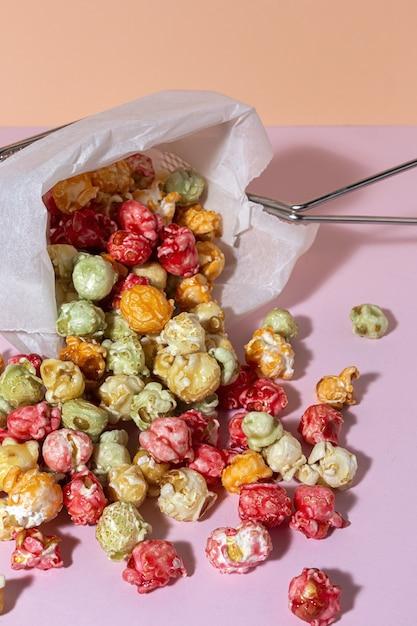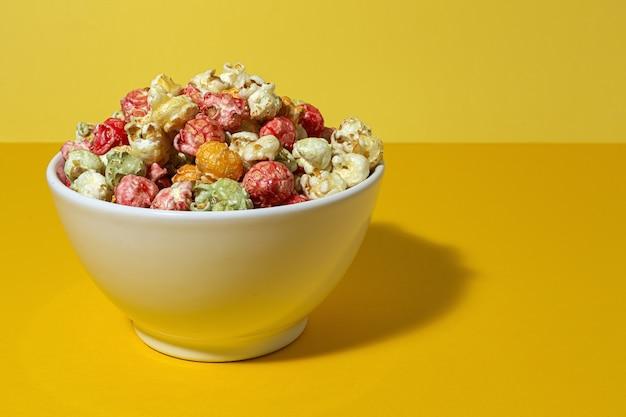Welcome to the world of DIY colored lights! If you’re bored with the plain white lights and want to add some pizzazz to your space, this blog post is for you. In this comprehensive guide, we’ll explore various methods and techniques to transform your ordinary lights into a vibrant, colorful display.
Have you ever wondered if it’s possible to change the color of a light bulb? Can you safely cover LED lights? What type of paint is heat resistant and suitable for light bulbs? We’ll address these questions and many more as we dive into the captivating world of DIY colored lights.
Be it for a festive occasion, a cozy ambiance, or just for the fun of it, you’ll learn how to create your own colored light bulbs, paint light fixtures, and even make your own LED lights. So, let your creative spirit soar as we uncover the secrets to making your home shine with personalized hues. Let’s get started!
How to Add a Pop of Color to Your Space with DIY Colored Lights
Are you tired of the same old boring lighting in your space? Do you find yourself yearning for a way to add some excitement and personality to your room? Well, look no further! In this guide, we’ll show you how to make your own DIY colored lights that will transform your space into a vibrant haven.
Gather Your Supplies
Before we dive into the nitty-gritty of making your own colored lights, let’s gather the supplies you’ll need. Don’t worry, we won’t send you on a wild goose chase for obscure items. Here’s a handy list of what you’ll need:
- LED light strips
- Wire cutters
- Electrical tape
- Power supply
- Remote control (optional for added convenience)
Let the Magic Begin with LED Light Strips
LED light strips are the key ingredient in creating your DIY colored lights. These versatile strips are available in a variety of colors, lengths, and even have options for adjustable brightness. Pick the color that resonates with your style and will make your space shine.
Measure, Cut, and Connect
Once you have your LED light strip, it’s time to unleash your inner handyman. Measure the length of your desired lighting area and cut the LED strip accordingly. Don’t worry if you’re not an expert with wire cutters; most LED light strips have clearly marked cut points to guide you.
Next, connect the cut ends of the strip to a power supply. You’ll need to use electrical tape to secure the connection and ensure a stable flow of electricity. Now you’re ready to bring your DIY colored lights to life!
Set the Mood with Remote Control (Optional)
If you’re a fan of convenience and love to control your lighting at the touch of a button, consider using a remote control. Some LED light strips come with a remote control feature that allows you to change colors, adjust brightness, and even create different lighting patterns. It’s like having your very own light show in the comfort of your space!
Get Creative with Placement
Now that your DIY colored lights are up and running, it’s time to get creative with their placement. Think beyond traditional lighting fixtures and explore unique ways to incorporate colored lights into your space. Here are a few ideas to spark your imagination:
Bed or Headboard
Create a serene ambiance in your bedroom by placing the colored lights under your bed or along the headboard. The soft glow will add a touch of enchantment to your personal sanctuary.
Shelves or Cabinets
Illuminate your favorite books or display items by placing the LED light strips on shelves or inside cabinets. It’s an instant way to add a magical touch to your beloved treasures.
Ceiling or Wall Accents
Want to make a bold statement? Install the LED light strips along the ceiling or create geometric patterns on a wall. Your DIY colored lights will instantly become a conversation starter!
Congratulations, you’ve successfully added a pop of color to your space with your very own DIY colored lights! Remember to experiment and have fun with different placements and color combinations. Let your creative juices flow and enjoy the mesmerizing effect of your personalized lighting. Now, go dazzle your friends with your newfound lighting wizardry!
DIY Colored Lights: Frequently Asked Questions
Can You Paint a Light Bulb to Change the Color
Yes, you can paint a light bulb to change its color! It’s a fun and creative way to add some pizzazz to your lighting. But before you grab your paintbrush, here are a few things to keep in mind.
What Kind of Paint Is Safe for Light Bulbs
When painting light bulbs, it’s crucial to use a paint that can withstand the heat emitted by the bulb. Look for paint specifically designed for high-temperature applications or heat-resistant paint. This will ensure that the paint doesn’t peel or melt when the bulb is turned on.
Is It Safe to Cover LED Lights
Covering LED lights can reduce their lifespan and affect their performance. LED lights generate heat, and covering them can trap this heat, potentially leading to overheating. It’s best to leave LED lights uncovered for optimal performance and longevity.
What Kind of Paint Is Heat Resistant
To paint objects that are exposed to heat, such as light bulbs or light fixtures, it’s important to choose a heat-resistant paint. Look for paint labeled as heat-resistant or designed for high-temperature applications. This type of paint can withstand the heat without deteriorating.
How Do You Make Colored Light Bulbs
Making colored light bulbs is a creative and easy process. You can use either translucent paint or colored filters. If using paint, simply apply a thin, even layer to the outside of the bulb and let it dry. If using filters, cut them to size and attach them securely to the bulb. When the bulb is turned on, you’ll enjoy a beautiful splash of color.
Can I Make My Own LED
While it’s technically possible to make your own LED, it requires advanced knowledge and specialized equipment. Unless you’re an electronics whiz or enjoy taking on complex projects, it’s easier and more cost-effective to purchase pre-made LED lights.
Can You Paint Light Globes
Yes, you can paint light globes! It’s a fantastic way to customize your lighting fixtures and add personality to a room. Just make sure to use paint that is safe for heat and compatible with the type of material your light globes are made of.
Can You Spray Paint Christmas Lights
Spray painting Christmas lights is not recommended. The paint can damage the wires and insulation, posing a fire hazard. Instead, opt for colored bulbs or light covers specifically designed for use with Christmas lights.
Is Acrylic Paint Heat Resistant
Acrylic paint is not inherently heat resistant. While it can withstand moderately high temperatures, it’s best to use a paint specifically labeled as heat resistant for objects exposed to intense heat, such as light bulbs or light fixtures.
Can You Paint Light Fixtures
Absolutely! Painting light fixtures is an excellent way to give them a fresh look and tie them into your home decor. However, be mindful of using heat-resistant paint if the fixtures generate a significant amount of heat.
Is Oil-Based Paint Better Than Water-Based
Whether oil-based or water-based paint is better depends on the specific project and the material you’re painting. Oil-based paints generally provide greater durability and resistance to wear and tear, making them suitable for high-traffic areas. Water-based paints, on the other hand, are easier to clean up and have less odor. Choose the type of paint that suits your needs and preferences.
Is Glass Paint Heat Resistant
Glass paint is specifically formulated to withstand high temperatures and adhere to glass surfaces effectively. If you’re looking to paint glass light fixtures or bulbs, using heat-resistant glass paint is essential for a long-lasting and visually stunning finish.
Can I Paint LED Lights
You can technically paint the outer casing of LED lights, but it’s not recommended. The paint may interfere with the heat dissipation of the LEDs, leading to overheating and reduced lifespan. To enjoy the benefits of LED lights, it’s best to leave them unpainted.
Can You Paint Fluorescent Light Bulbs
Fluorescent light bulbs have a special coating that transforms the UV radiation they emit into visible light. Painting the coating can interfere with this process, diminishing the bulb’s efficiency and light output. It’s best to avoid painting fluorescent light bulbs.
What Happens If You Paint a Light Bulb
If you paint a light bulb with paint that is not heat resistant, the paint can melt, emit harmful fumes, or even cause the bulb to shatter. It’s crucial to use paint specifically designed for high temperatures to ensure safety and preserve the bulb’s functionality.
How Do I Change the LED Color on My iPhone
To change the LED color on your iPhone, go to the “Settings” app, select “Display & Brightness,” then tap on “Color Filters.” Enable the “Color Filters” option and choose the desired color filter to change the LED color on your iPhone.
How Do You Color LED Lights
To color LED lights, you can use colored filters specifically made for LED fixtures. These filters attach easily to the light fixtures and provide a vibrant color effect. Another option is to use smart LED light bulbs that allow you to change the color via a mobile app or voice command.
Can You Paint Clear Christmas Lights
It’s not recommended to paint clear Christmas lights. The paint may interfere with the light’s dispersion, creating uneven illumination or even causing the bulbs to overheat. Instead, opt for pre-colored or specialty Christmas lights to achieve the desired effect.
Can You Paint a Light Bulb with Nail Polish
While it may be tempting to use nail polish to paint a light bulb, it’s not a safe or recommended method. Nail polish is not designed to withstand high temperatures, and when applied to a light bulb, it can create a fire hazard or release harmful fumes. Stick to paints specifically designed for heat-resistant applications.
How Do You Make Colored Lights at Home
To make colored lights at home, there are several creative options. You can use colored filters over existing light sources or invest in colored LED bulbs. You can also explore DIY projects like painting light fixtures or utilizing colored gels over light sources to achieve stunning colored lighting effects.
Enjoy getting creative and transforming your space with DIY colored lights! Remember to prioritize safety, use appropriate materials, and have fun exploring the endless possibilities.

